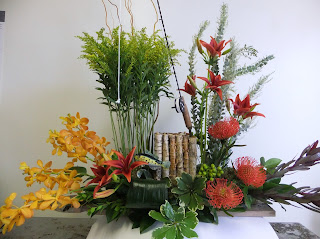 Carnation...January's Birthday Flower
Carnation...January's Birthday Flower
As early as 1870, the carnation was one of the florists' most frequently used "bread and butter" flowers. Its Victorian Era popularity was no doubt key to its selection in 1904 as the flagship flower for the newly instituted observance of Mother's Day. In 1900 President McKinley wore a carnation in his lapel each day. His birthday, January 29, was officially established as "Carnation Day."
 The carnation is an example of a "mass flower," meaning a single, rounded flower at the top of a stem used for adding volume to a design.
The carnation is an example of a "mass flower," meaning a single, rounded flower at the top of a stem used for adding volume to a design.
Carnations are sometimes used in a "basing technique," a finishing of the foundation of a composition with intricate, textured details, which provide a decorative surface from which the composition of the design emerges.
In Victorian times, the carnation stood for fascination; deep red was a sign of a love stricken heart, and red for love. Yet, if the carnation was striped, it meant love's refusal.




 Today many people do not like the carnation, preferring more exotic blossoms. This is perhaps because it is inexpensive and commonly used (and over-used) in wire-service arrangements during busy holiday times. But the carnation, when used creatively, adds a unique texture to flower arrangements, as well as it's trademark spicy fragrance.
Today many people do not like the carnation, preferring more exotic blossoms. This is perhaps because it is inexpensive and commonly used (and over-used) in wire-service arrangements during busy holiday times. But the carnation, when used creatively, adds a unique texture to flower arrangements, as well as it's trademark spicy fragrance. 




































.jpg)





